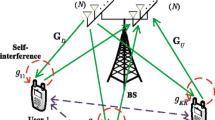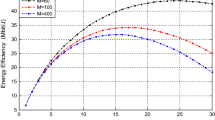Abstract
In this paper, energy efficiency (EE) of the frequency division duplexing (FDD) massive multiple-input multiple-output (MIMO) systems in the downlink transmission is investigated by considering the channel aging effect. First, we present a model for channel aging in the FDD massive MIMO systems and study its effect on the EE of the system. We assume that the channel aging exists in the entire transmission frame of the FDD systems which includes both pilot and data transmission phases. Then, we propose methods for compensating for this effect and increasing the EE. These methods include channel prediction method in the pilot transmission phase, system’s parameters optimization for maximizing the EE and a hybrid method. By numerical simulations, we compare the performance of the proposed methods and their abilities to combat the channel aging effect in the massive MIMO systems and EE improvement.






Similar content being viewed by others
References
Chopra, R., Murthy, C. R., Suraweera, H. A., & Larsson, E. G. (2018). Performance analysis of FDD massive MIMO systems under channel aging. IEEE Transactions on Wireless Communications, 17(2), 1094–1108.
Kong, C., Zhong, C., Papazafeiropoulos, A. K., Matthaiou, M., & Zhang, Z. (2015). Sum-rate and power scaling of massive MIMO systems with channel aging. IEEE Transactions on Communications, 63(12), 4879–4893.
Chopra, R., Murthy, C. R., & Suraweera, H. A. (2016). On the throughput of large MIMO beamforming systems with channel aging. IEEE Signal Processing Letters, 23(11), 1523–1527.
Adhikary, A., Nam, J., Ahn, J. Y., & Caire, G. (2013). Joint spatial division and multiplexing the large-scale array regime. IEEE Transactions on Information Theory, 59(10), 6441–6463.
Truong, K. T., & Heath, R. W. (2013). Effects of channel aging in massive MIMO systems. Journal of Communications and Networks, 15(4), 338–351.
Papazafeiropoulos, A. K., Ngo, H. Q., & Ratnarajah, T. (2017). Performance of massive MIMO uplink with zero-forcing receivers under delayed channels. IEEE Transactions on Vehicular Technology, 66(4), 3158–3169.
Papazafeiropoulos, A. K. (2017). Impact of general channel aging conditions on the downlink performance of massive MIMO. IEEE Transactions on Vehicular Technology, 66(2), 1428–1442.
Chen, J., & Lau, V. K. N. (2014). Two-tier precoding for FDD multi-cell massive MIMO time-varying interference networks. IEEE Journal on Selected Areas in Communications, 32(6), 1230–1238.
Choi, J., Love, D. J., & Bidigare, P. (2014). Downlink training techniques for FDD massive MIMO systems: Open-loop and closed-loop training with memory. IEEE Journal of Selected Topics in Signal Processing, 8(5), 802–814.
Ma, J., Zhang, S., Li, H., Gao, F., & Jin, S. (2019). Sparse Bayesian learning for the time-varying massive MIMO channels: Acquisition and tracking. IEEE Transactions on Communications, 67(3), 1925–1938.
Xie, H., Gao, F., Zhang, S., & Jin, S. (2017). A unified transmission strategy for TDD/FDD massive MIMO systems with spatial basis expansion model. IEEE Transactions on Vehicular Technology, 66(4), 3170–3184.
Chopra, R., Murthy, C. R., Suraweera, H. A., & Larsson, E. G. (2019). Analysis of nonorthogonal training in massive MIMO under channel aging with SIC receivers. IEEE Signal Processing Letters, 26(2), 282–286.
Deng, R., Jiang, Z., Zhou, S., & Niu, Z. (2019). Intermittent CSI update for massive MIMO systems with heterogeneous user mobility. IEEE Transactions on Communications, 67(7), 4811–4824.
Lu, A., Gao, X., Zhong, W., Xiao, C., & Meng, X. (2019). Robust transmission for massive MIMO downlink with imperfect CSI. IEEE Transactions on Communications, 67(8), 5362–5376.
Li, J., Wang, D., Zhu, P., & You, X. (2017). Uplink spectral efficiency analysis of distributed massive MIMO with channel impairments. IEEE Access, 5, 5020–5030.
Zhao, N., Yu, F. R., & Sun, H. (2015). Adaptive energy-efficient power allocation in green interference-alignment-based wireless networks. IEEE Transactions on Vehicular Technology, 64(9), 4268–4281.
Zhao, N., Cao, Y., Yu, F. R., Chen, Y., Jin, M., & Leung, V. C. M. (2018). Artificial noise assisted secure interference networks with wireless power transfer. IEEE Transactions on Vehicular Technology, 67(2), 1087–1098.
Mahapatra, R., Nijsure, Y., Kaddoum, G., Ul Hassan, N., & Yuen, C. (2016). Energy efficiency tradeoff mechanism towards wireless green communication a survey. IEEE Communications Surveys & Tutorials, 18(1), 686–705.
Wang, Y., Li, C., Huang, Y., Wang, D., Ban, T., & Yang, L. (2016). Energy-efficient optimization for downlink massive MIMO FDD systems with transmit-side channel correlation. IEEE Transactions on Vehicular Technology, 65(9), 7228–7243.
Jakes, W. C. (1974). Microwave mobile communication. New York: Wiley.
Kay, S. M. (1993). Fundamentals of statistical signal processing: Estimation theory. Englewood Cliffs: Prentice Hall.
Kim, Y., Miao, G., & Hwang, T. (2014). Energy efficient pilot and link adaptation for mobile users in TDD multi-user MIMO systems. IEEE Transactions on Wireless Communications, 13(1), 382–393.
Prabhu, R. S., & Daneshrad, B. (2010) Energy-efcient power loading for a MIMO-SVD system and its performance in flat fading. In 2010 IEEE global telecommunications conference GLOBECOM 2010 (pp. 1–5). Miami, FL .
Hoydis, J., Brink, S. T., & Debbah, M. (2013). Massive MIMO in the UL/DL of cellular networks: How many antennas do we need? IEEE Journal on selected Areas in Communications, 31(2), 160–171.
Crouzeix, J., & Ferland, J. (1991). Algorithms for generalized fractional programming. Math Program, 52, 191–207.
Boyd, S., & Vandenberghe, L. (2004). Convex optimization. Cambridge: Cambridge University Press.
Press, W. H., Teukolsky, S. A., Vetterling, W. T., & Flannery, B. P. (2007). Numerical recipes: The art of scientific computing. New York: Cambridge University Press.
Yu, W., & Lui, R. (2006). Dual methods for non-convex spectrum optimization of multicarrier systems. IEEE Transactions on Communications, 54(7), 1310–1322.
Author information
Authors and Affiliations
Corresponding author
Additional information
Publisher's Note
Springer Nature remains neutral with regard to jurisdictional claims in published maps and institutional affiliations.
Appendices
Appendix A
Proof of the Theorem 1
In [9], an optimal pilot matrix has been obtained for a spatially correlated mode. We calculate the optimal pilot matrix, considering that the channel is changing from one symbol to another. Optimal pilot vectors that minimize MSE are obtained as
By substituting (8) in the above equation and choosing the vectors \(\varvec{\varphi }_n\) appropriately, the value of the \(\varvec{\varphi } _n^H \alpha ^k \mathbf {R} {{ \varvec{\varphi } }_{n-k}} =0;~k\ne 0\), can be reduced to zero. Therefore, we have
and considering \(\tilde{\varvec{\varphi } }_l = {\mathbf {U}^H}\varvec{\varphi }_l\), we have
The above equation is the sum of the positive fractions, and it is maximized when the amount of each fraction is maximized. By derivation from (56) respect to \(\tilde{\varvec{\varphi }}_l\) and simplifying, \(\tilde{\varvec{\varphi }}_l\) is obtained as
Therefore, optimal pilot vectors are
Since the pilots are the eigen vectors of the channel covariance matrix and they are orthogonal to each other, hence, the initial considered assumption is correct.
Appendix B
Proof of the Theorem 2
Optimal pilot vectors that minimize MSE are obtained as
The above optimization problem is equivalent with
where \(\text {tr} (\varvec{\Theta })\) is calculated as
By choosing the vectors \(\varvec{\varphi }_n\) appropriately, the value of the \(\varvec{\varphi } _n^H \alpha ^k \mathbf {R} {{ \varvec{\varphi } }_{n-k}} =0;~k\ne 0\), can be reduced to zero. Therefore, we have
By substituting (2) in the above equation and considering \(\tilde{\varvec{\varphi }}_i = {\mathbf {U}^H}\varvec{\varphi } _i\), the above equation is as
By derivation of the above equation and equating it to zero, the optimal pilot vectors are obtained as
Rights and permissions
About this article
Cite this article
Ahmadabadian, M., Khavari Moghaddam, S. & Razavizadeh, S.M. Energy efficiency maximization in FDD massive MIMO systems with channel aging. Wireless Netw 26, 4031–4044 (2020). https://doi.org/10.1007/s11276-020-02306-2
Published:
Issue Date:
DOI: https://doi.org/10.1007/s11276-020-02306-2




